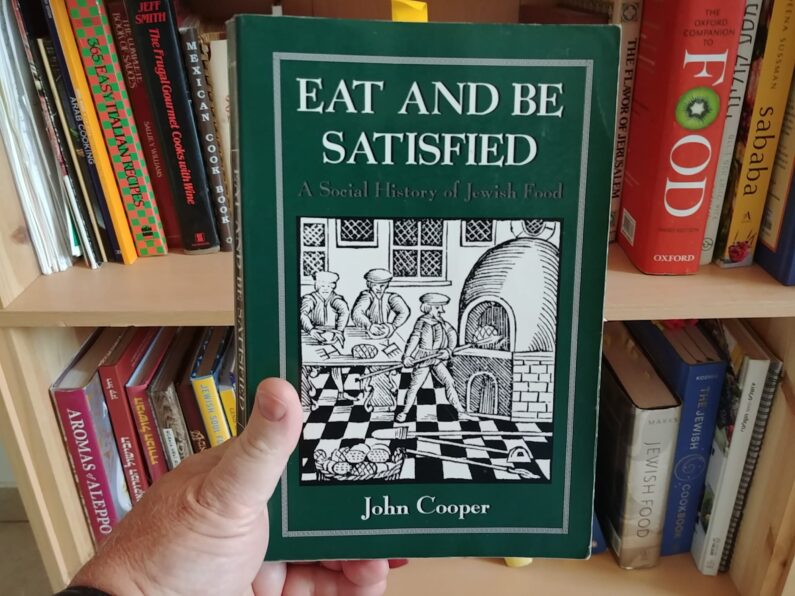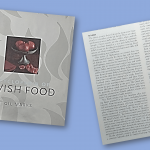For this edition of From the Jewish Food Bookshelf, I wanted to talk about the second of my top three resources for Jewish Food History. I previously wrote about Gil Marks’ excellent Encyclopedia of Jewish Food, which I reference repeatedly when looking into a topic. John Cooper’s Eat and Be Satisfied: A Social History of Jewish Food is a different sort of work that I probably consult at least as frequently.
While Marks’ work is — as the name spells out — an encyclopedic reference text, Cooper’s book is straight up food history writing. In it, Cooper basically addresses in pure and simple language the important question: what did Jews eat from ancient times until today? At just barely over 200 pages, Cooper’s book is concise without sacrificing breadth, perhaps explaining why it is a text that is one of the most widely quoted by other food writers, and which is still in print some thirty years after its initial publication (and despite the defunct state of the original publisher).
Organization of the Book
Eat and Be Satisfied proceeds generally chronologically, eventually splitting into two parallel tracks for the modern period. The book begins with food in Biblical Israel, where a surprisingly large amount of information can be extrapolated from archaeology, the Torah, and other sources. From there, it proceeds to explore the dietary laws, which have their foundations in the Torah, of course, but which also were changed and expanded in the post-Biblical and Rabbinic periods. Cooper then moves forward to the Talmudic Age followed by the Medieval period. But from then, the book looks first at Sephardic food and then Ashkenazic.
In most periods, there is also a second internal split. Perhaps obvious, but not always remembered explicitly, the foods that Jews have eaten throughout our history differed not only from place to place, but also from day to day within a given place. Cooper cleverly looks both at everyday foods as well as foods for Shabbat and Festivals.
Pros and (Minor) Cons
I particularly appreciate Cooper’s approach in this book, as I feel mine is somewhat similar. He draws on an extremely diverse array of source materials, though most are secondary sources. I do the same in most of my research. Also, unlike the other two of my three top selections, Eat and Be Satisfied is extensively footnoted, a pet peeve I have with many food books. Everyone (myself included, I’m sure) writes things that might seem a bit specious at times, but if when I read such material I can check where the author got his or her information, I can judge better the accuracy of the statement. Without such references, I can only poke around to look for corroborating info in other sources or simply choose to trust the author.
The endnotes here are in a bit of an old-fashioned style, where there is essentially one long list of references for an entire paragraph, which does make it slightly harder to follow up. But that is a minor complaint, and I’m really just happy that he listed his sources at all.
Another minor issue I have with Eat is that not infrequently, Cooper finds an example of something done by someone in a given community, and he portrays it as universal to that community. He might write something like, “The Jews of Kurdistan ate…” even though he may have only found one reference to such a thing. He is not the only food writer to do this, and it is less problematic here since (as mentioned above) he footnotes. By checking the source, one can determine if it is a more universal practice or one that was specific to an individual. (The nature of food is such that what any given cook prepares is not only influenced by the culture in which s/he lives, but also on the personal tastes of the cook’s family.)
Finally, while I greatly value Cooper’s concise style, it also creates a somewhat dry and academic tone that might not be for everyone. If you are looking for a fun or entertaining read, this is probably not the book for you. But if you gain your entertainment from the information itself, this highly readable text should perfectly hit the spot!
Please Share This With Someone Else Who’d Appreciate It






Jewish Food Names We Rarely Think About
[…] Spanish and Latin communities is called truchas a la judia, made using trout instead of carp.(4)John Cooper Eat and Be Satisfied Encountering such similar foods in two such vastly different cuisines also underscores the […]
Eliezer Meir Saidel
I am trying to contact John Cooper. Do you perhaps have any contact info for him?
FunJoel
Eliezer — I replied via email.